There are hundreds and thousands of interesting facts about Hinduism. Hinduism is the oldest religion globally, and history can be traced back to 5000-10,000 B.C. The practitioners and scholars refer to it as a Sanātana Dharma (Eternal Religion). Hinduism is developed out of Brahmnisim and it has no founder.
Many scholars and practitioners also believe that all the religions (Buddhism, Christianity, Confucianism, Islam, Jainism, Judaism, Shinto, Sikhism, Taoism, and Zoroastrianism) have originated from Hindusim, originally the Sanātana Dharma.
Hinduism is the third-largest religion in the world with 1.1 billion adherents worldwide. It accounts for 16% of the world’s total population. Nepal (81.3%) and India (79.28%) are countries with a majority of Hindus populations.
In this article, we are going to cover 20 such interesting facts about Hinduism. Here are they:
Interesting Facts About Hinduism
1. The Real name is Sanātana Dharma
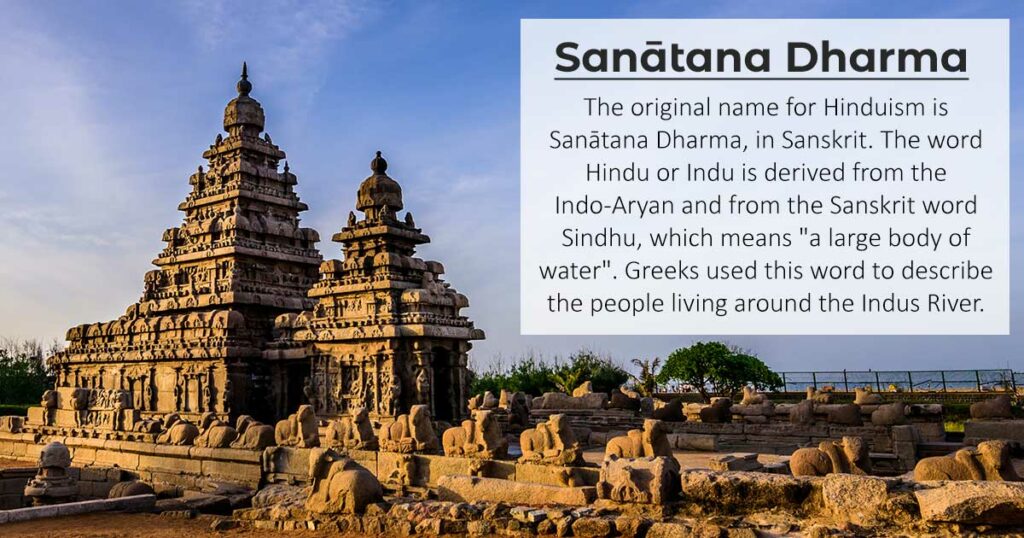
The original name for Hinduism is Sanātana Dharma, in Sanskrit. The word Hindu or Indu is derived from the Indo-Aryan and from the Sanskrit word Sindhu, which means “a large body of water”. Greeks used this word to describe the people living around the Indus River.
By the 13th century, India became popular by the name Hindustan. It is believed that English writers added -ism to Hindu in In the 19th century. Later, it was adopted by the Hindus themselves.
2. The goal of life in Hinduism is to attain “Moksha” or “Salvation”
In Hinduism, the ultimate goal of life is to achieve Moksha or liberation from the cycle of birth and rebirth (Samsara). Hindus believe that life has four main objectives: Dharma (righteousness and moral duty), Artha (prosperity and success), Kama (pleasure and emotional fulfilment), and Moksha (spiritual liberation).
Each of these stages guides individuals through life, helping them balance personal desires with spiritual growth. The journey towards Moksha involves self-realization, understanding the nature of the self, and union with the divine, marking the soul’s final release from worldly existence.
3. Hinduism Believes in Only One God
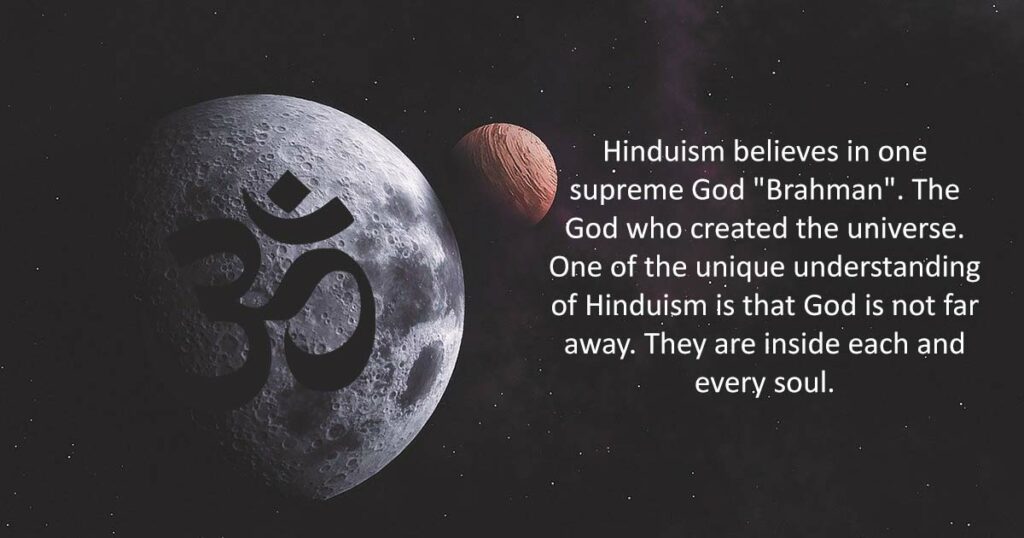
Hinduism believes in one supreme God “Brahman”. The God who created the universe. One of the unique understanding of Hinduism is that God is not far away. They are inside each and every soul.
Brahman
Hinduism cannot be classified as Polytheistic or Monotheistic. Rather, Monism is the Hindu belief that everything is Brahman (God).
Within the religion, Gods and Goddesses possess different aspects of Brahman. For example:
- Lord Shiva: Lord Shiva is known as a destroyer within the Trimurti that includes Brahma and Vishnu.
- Brahma: Brahma is known as the creator of the universe.
- Vishnu: Lord Vishnu is known as the preserver and protector of the universe.
- Ganesha: Lord Ganesha is the remover of obstacles.
4. Deities
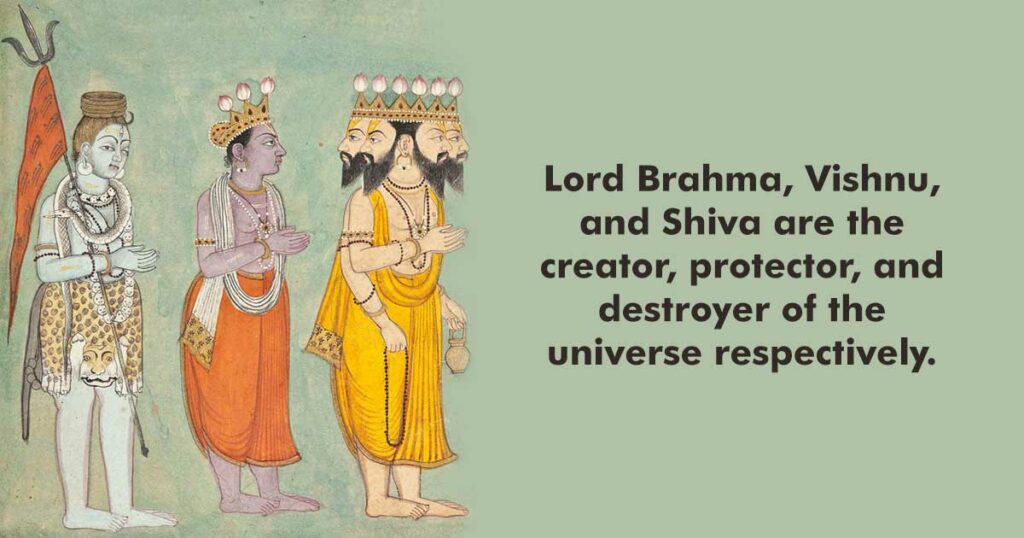
In Hinduism, Lord Brahma, Vishnu, and Shiva form the Holy Trinity, each representing a vital cosmic function. Brahma is the creator, responsible for the origin of all beings. Vishnu, the protector, sustains and preserves the universe, ensuring balance and harmony. Shiva, the destroyer, represents transformation and the end of cycles, clearing the path for new beginnings.
Beyond the Trinity, other deities hold significant importance. Lord Rama and Krishna, incarnations of Vishnu, embody righteousness and divine love. Lord Ganesha is revered as the remover of obstacles, while Lord Hanuman symbolizes strength and devotion.
Among goddesses, Durga represents protection and empowerment, Lakshmi is the goddess of wealth and prosperity, and Parvati, Shiva’s consort, symbolizes nurturing energy and love. Together, these deities are widely worshipped and play vital roles in guiding devotees’ spiritual and material lives.
5. Deities (Male or Female) are worshipped with equal reverence
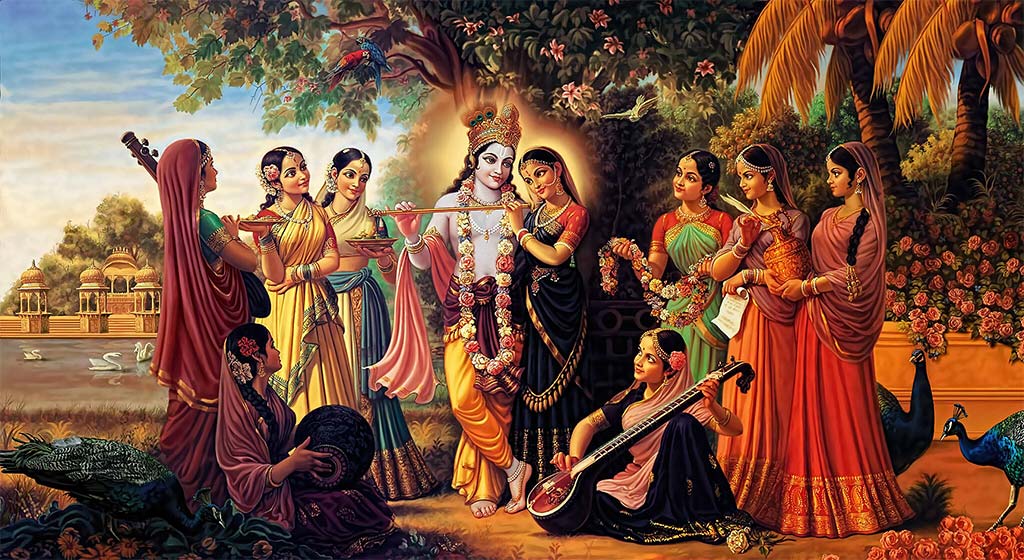
In Hinduism, both male and female deities are worshipped with equal reverence, symbolizing the balance of masculine and feminine energies in the universe. Male deities, like Brahma, Vishnu, and Shiva, represent creation, preservation, and destruction, while female deities, such as Durga, Lakshmi, and Saraswati, embody power, prosperity, and wisdom.
Together, these deities emphasize the complementary roles of both genders in maintaining cosmic order. Female deities are not seen as subordinate but as essential forces in their own right, representing Shakti, the divine feminine energy that powers all existence.
6. Circular Concept of Time
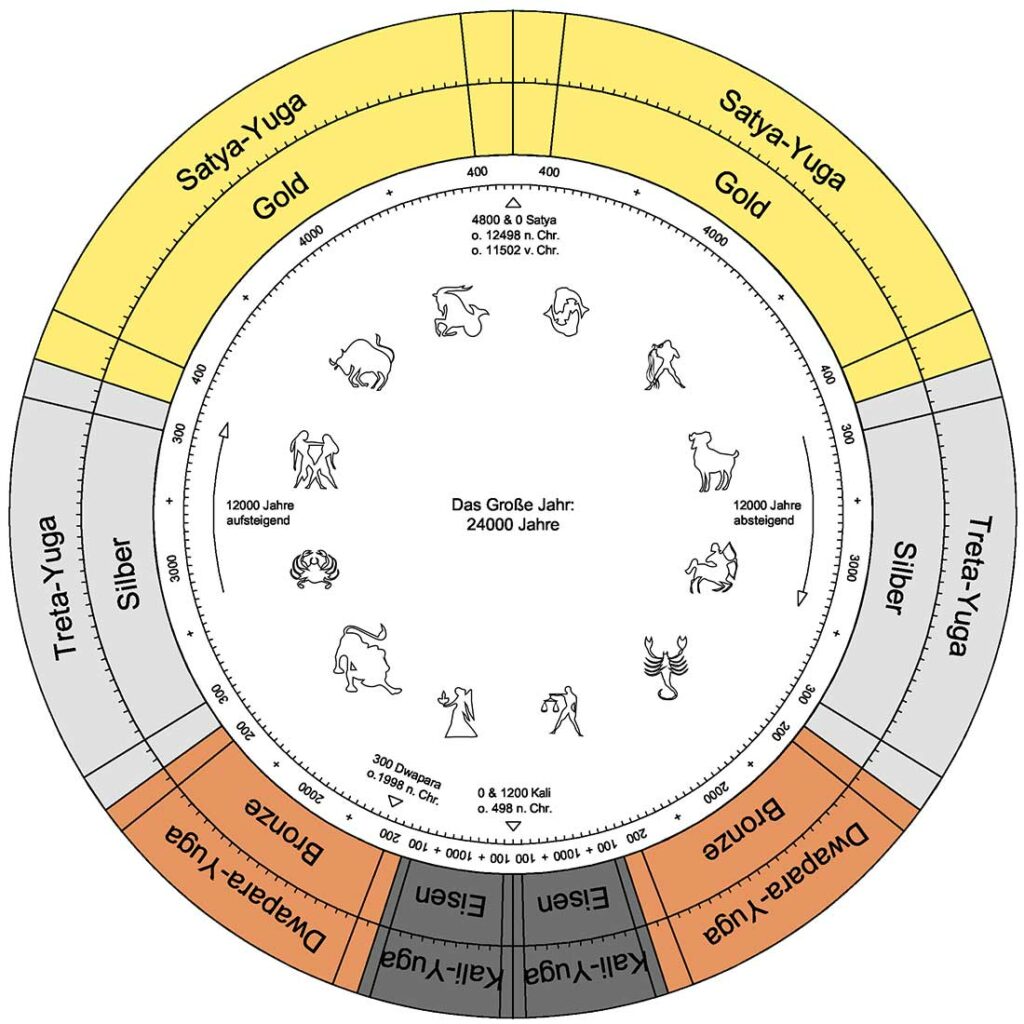
Hinduism views time as cyclical rather than linear, with the universe undergoing endless cycles of creation, preservation, and destruction. Time is divided into four yugas or ages, each progressively shorter and morally degraded than the one before.
The first is Satya Yuga, a golden age of truth and virtue. Treta Yuga follows, marking a decline in moral standards, followed by Dvapara Yuga, where chaos and disorder begin to rise. Lastly, Kali Yuga is the current age, characterized by darkness, ignorance, and strife, believed to lead to renewal after its end.
7. Stages of Life
According to Hinduism, there are four stages of life in one life cycle. They are:
- Brahmcharyashram (till 24): Early and student life.
- Grihastahshram (24-48): Life after marriage (Living with wife and children).
- Vanprasthashram (48-72): Leaving for a distant land in the and pray to God. May keep in contact with the family.
- Sanyasashram (72+ or anytime): Discard everything in life including material things, family, wife, and children.
8. Om Represents the Sound of the Universe
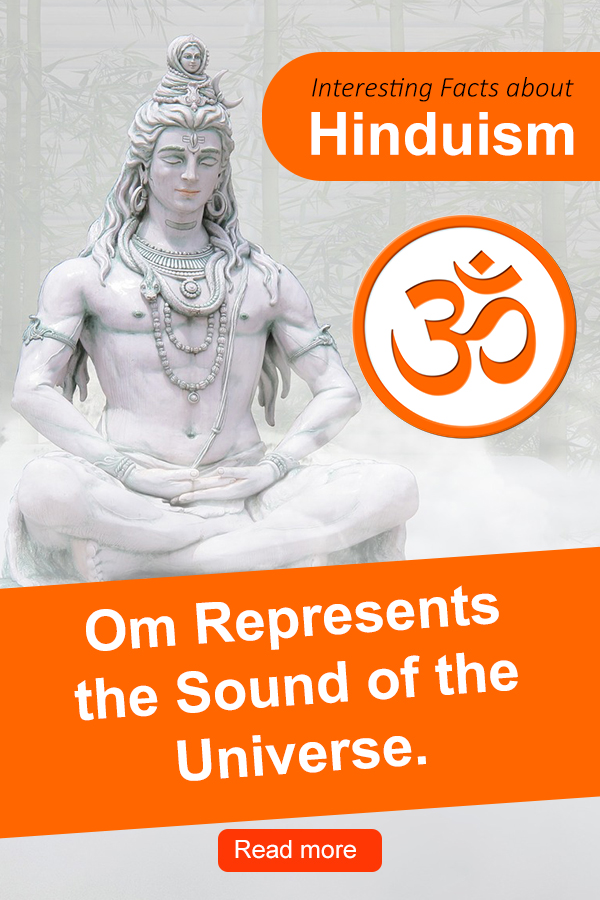
In Hinduism, Om is the most sacred syllable, symbolizing the essence of the universe and the ultimate reality, Brahman. It represents the sound of creation, often referred to as the vibration of the cosmos. Om is chanted independently or before mantras during rituals and meditation, helping align the mind with divine energy.
This sacred sound also transcends Hinduism, being used in Jainism, Buddhism, and Sikhism. In these traditions, Om holds significance in spiritual practices and is regarded as a universal symbol of inner peace and unity.
9. Sacred Number
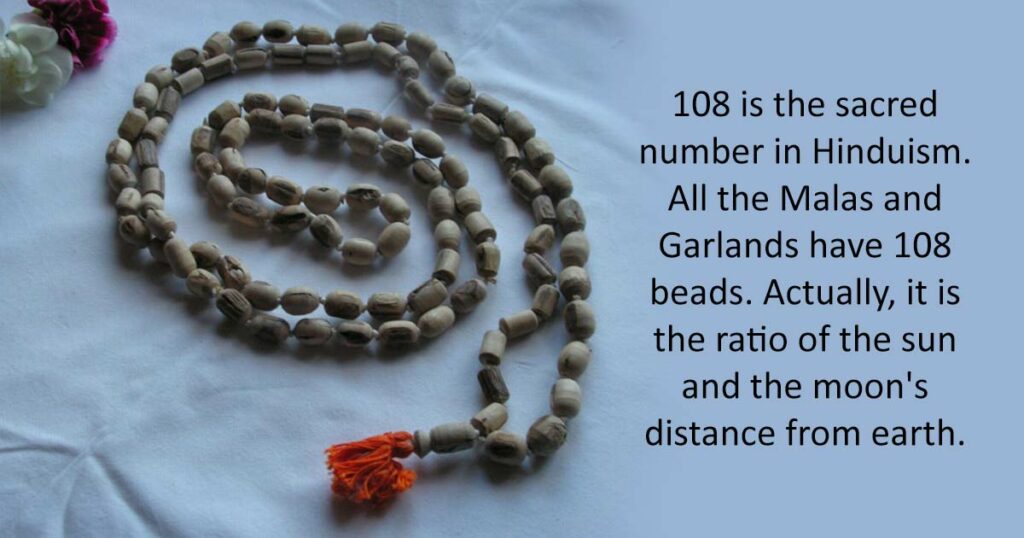
In Hinduism, the number 108 is considered sacred and holds deep spiritual significance. This number is commonly found in malas (prayer beads) and garlands, which traditionally consist of 108 beads. The significance of 108 is often linked to various spiritual practices, as it is believed to represent the universe’s relationship with the divine.
Interestingly, the ratio of the distances from the Earth to the sun and moon approximates 108, further emphasizing its cosmic connection. Chanting mantras 108 times is thought to deepen meditation and enhance spiritual growth, making it a vital aspect of Hindu worship and spirituality.
10. Vedas, Upanishad and Puranas
In Hinduism, the foundational texts are the four Vedas: the Rig Veda, Sama Veda, Yajur Veda, and Atharva Veda.
Each Veda serves a unique purpose, encompassing hymns, rituals, philosophies, and knowledge that guide spiritual practice and societal norms. Alongside the Vedas, there are 18 Puranas, which are ancient texts that narrate the history of the universe, genealogies of gods, and mythological tales, enriching Hindu culture and spirituality.
Additionally, the 108 Upanishads explore philosophical concepts and spiritual wisdom, forming an essential part of Hindu thought and teaching the path to ultimate reality and self-realization. Together, these texts constitute a vast and profound literary tradition that continues to influence millions of followers today.
11. Oldest Holy Book in the World
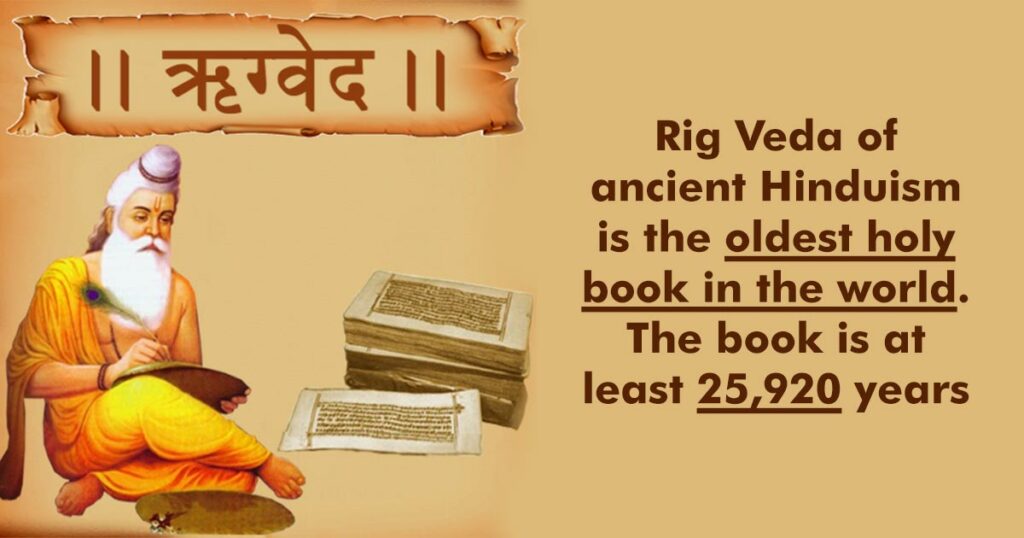
The Rig Veda, regarded as the oldest holy book in the world, is a cornerstone of ancient Hinduism, likely composed between 1700 and 1100 BCE. Scholars and practitioners believe its teachings may date back at least 25,920 years, reflecting a profound historical and spiritual significance.
The text comprises hymns dedicated to various deities and rituals, forming the foundation for Vedic literature and influencing the spiritual landscape of Hinduism for millennia.
12. The Best Gifts of Hinduism to the World
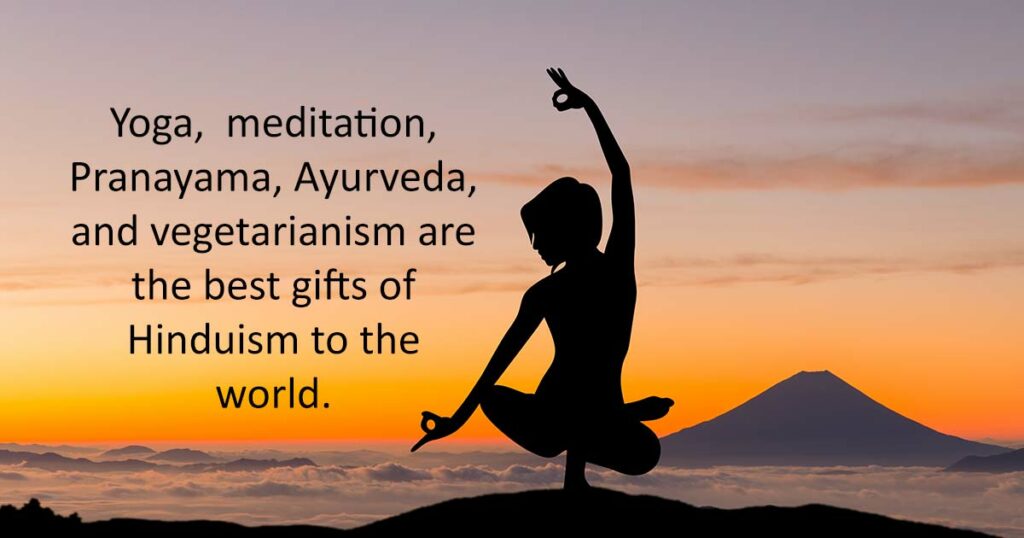
- Yoga, meditation, Pranayama, Ayurveda, and vegetarianism are the best gifts of Hinduism to the world.
- The Neotantra, Navtantra or Tantric sex, Palmistry, acupuncture, acupressure, Jyotish Shastra, and martial arts originated in India in Hinduism.
- Zero, decimal and point systems were also invented in India.
13. Sanskrit – mother of all languages
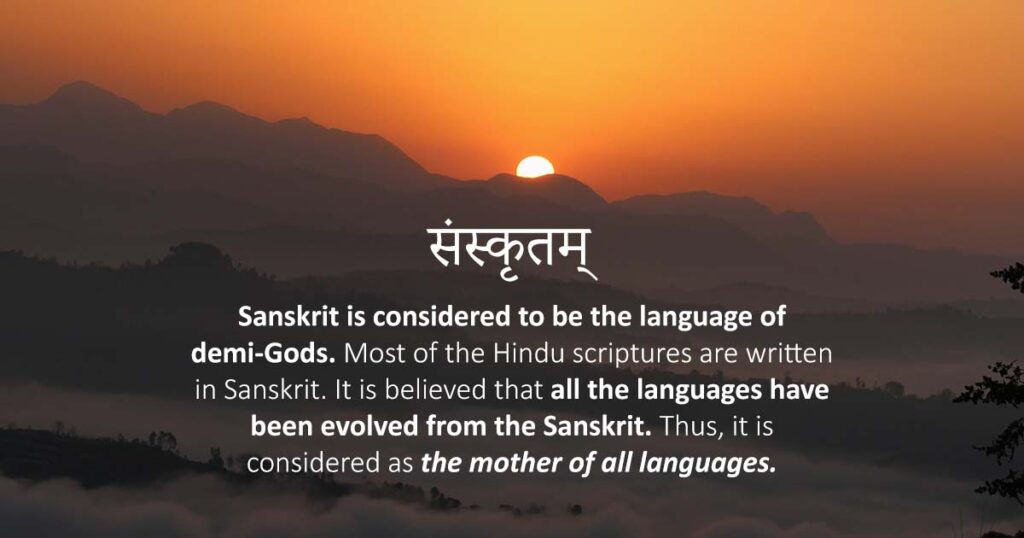
Sanskrit is revered as the language of the demi-gods and is the primary medium for most Hindu scriptures. It is often regarded as the mother of all languages, with many languages believed to have evolved from it.
This ancient language not only carries spiritual significance but also embodies rich philosophical concepts, making it an essential component of Hindu literature and thought.
Its complexity and depth continue to fascinate linguists and scholars, highlighting its enduring legacy in the world of language and culture.
14. Hinduism Encourages a Vegetarian Diet
Hinduism strongly advocates for a vegetarian diet, with many Hindus opting to avoid non-vegetarian food. Hindu texts describe vegetarianism as Satvic, promoting purity for both body and mind.
This dietary choice aligns with the principles of non-violence (ahimsa) and compassion, emphasizing the importance of respecting all living beings. By consuming a vegetarian diet, followers believe they can achieve spiritual clarity and harmony.
15. Anyone can attain salvation
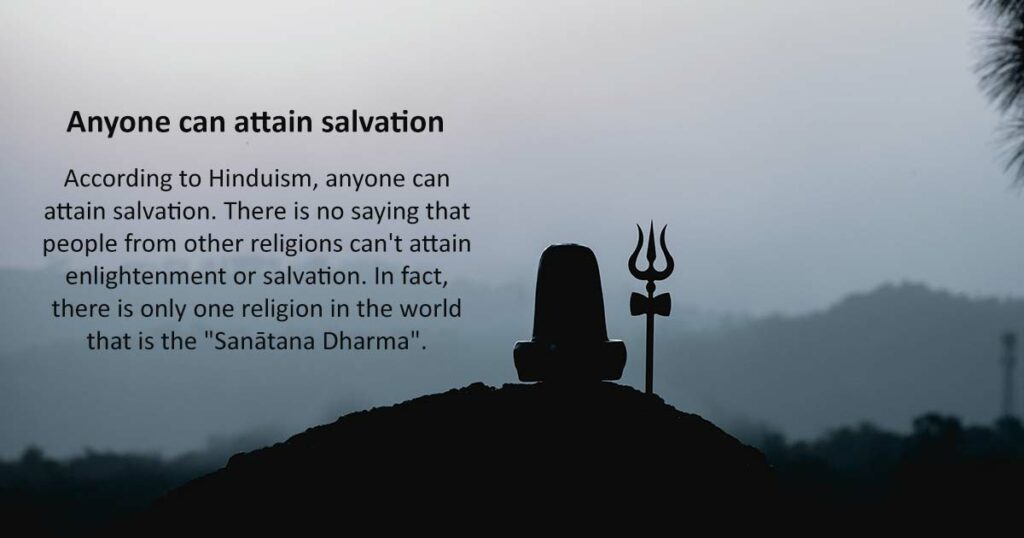
In Hinduism, anyone can attain salvation, and there are no restrictions based on religion. It recognizes that individuals from all faiths can achieve enlightenment.
The concept of Sanātana Dharma, often referred to as the eternal truth or duty, represents the belief that there is one universal religion that transcends boundaries. This inclusive perspective encourages spiritual growth and understanding among all people, regardless of their backgrounds.
16. Hindus Believe in Karma
Hinduism strongly believes in the principle of karma, which asserts that individuals who do good in life will receive positive outcomes, while those who engage in negative actions will face consequences.
This concept is not unique to Hinduism; it is also a fundamental belief in other religions, including Jainism, Buddhism, and Sikhism. The law of karma encourages ethical behavior and accountability, emphasizing that one’s actions directly impact their future experiences and spiritual journey.
17. Yoga
Yoga is a vital part of Hinduism. The word “Yoga” is derived from the Sanskrit word “yuj” which means unite. Most of the Hindu texts describe Yoga as a practice to control the sense and mind.
In Shrimad Bhagwat Geeta, Shri Krishna speaks about four types of yoga – bhakti, or devotion; jnana, or knowledge; karma, or action; and dhyana, or concentration.
18. Kumbh Mela
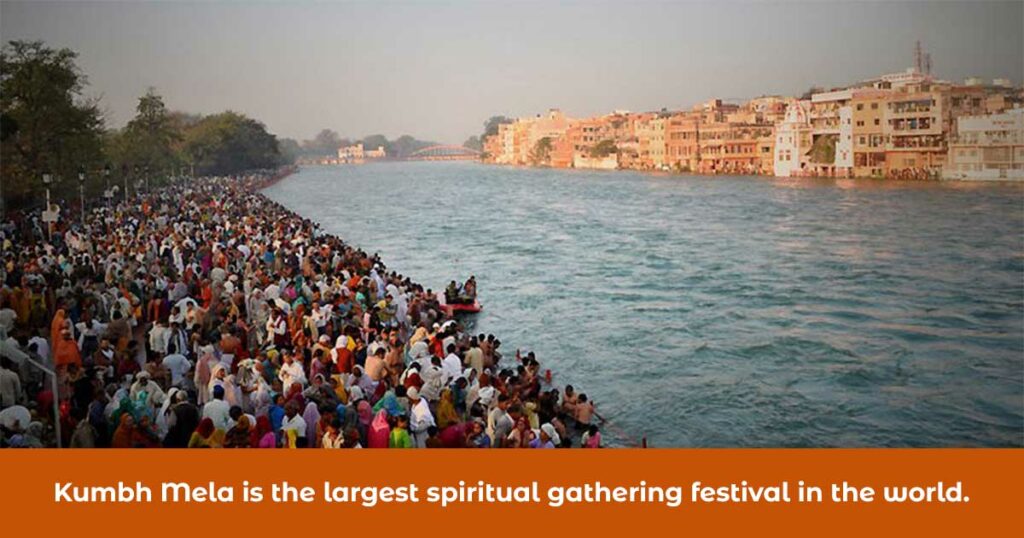
Kumbh Mela is recognized as the largest spiritual gathering in the world, attracting millions of participants. On February 10, 2013, over 30 million people attended the festival in a single day.
This significant event, celebrated at various locations in India, symbolizes the spiritual essence of Hinduism and promotes communal harmony. Its cultural importance was acknowledged when UNESCO awarded it the status of cultural heritage. Kumbh Mela continues to be a major pilgrimage for Hindus, drawing devotees seeking spiritual renewal.
19. Hindu Temples
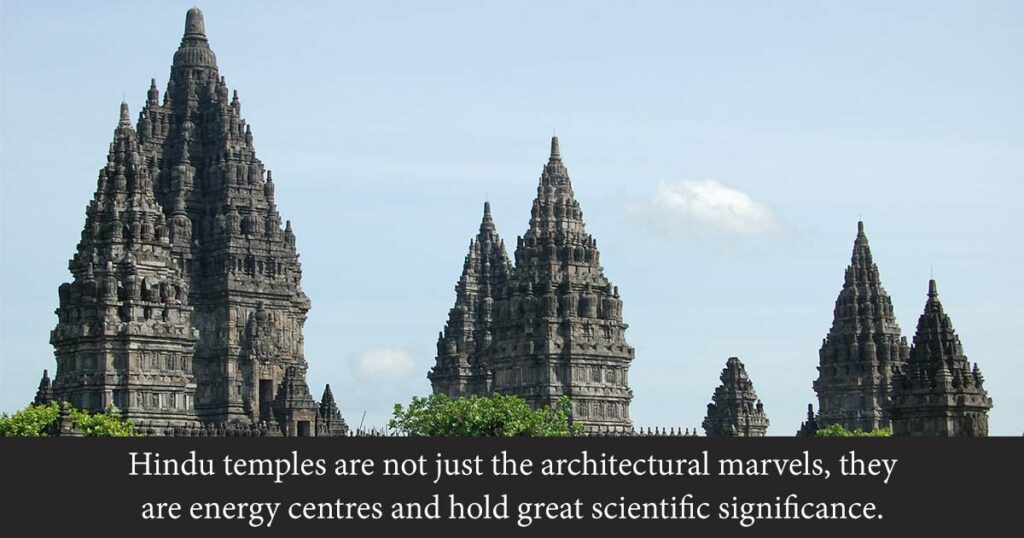
Hindu temples are not only architectural marvels but also serve as energy centres with significant scientific relevance. They are designed to enhance spiritual vibrations and promote a sense of peace and tranquillity.
The layout and orientation of temples often incorporate principles of geometry and astronomy, believed to channel positive energy. This blend of spirituality and science underscores the profound understanding of natural laws embedded in temple architecture, making them important cultural and spiritual landmarks in Hinduism.
20. Richest Religious Structure
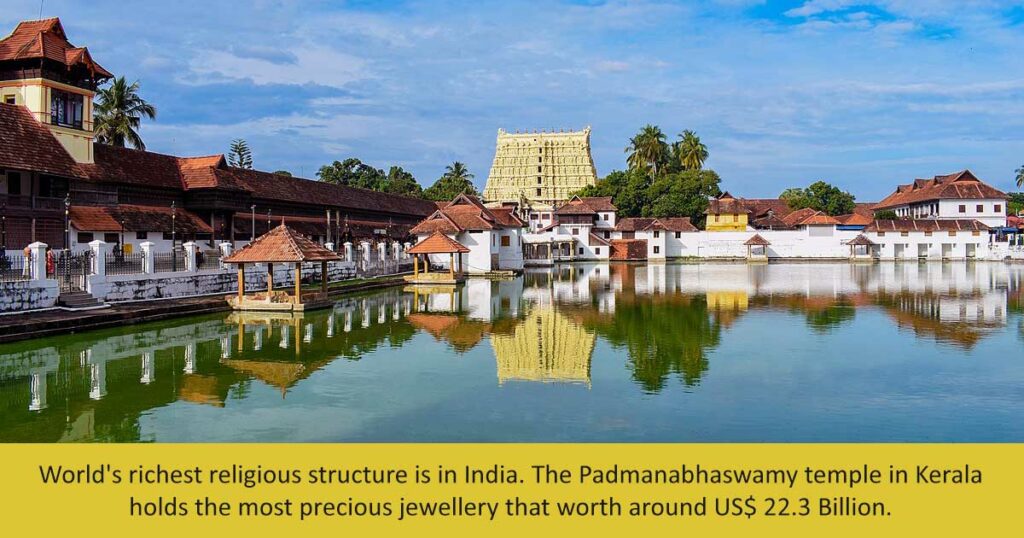
The world’s richest religious structure is in India. The Padmanabhaswamy temple in Kerala holds the most precious jewellery that worth around US$ 22.3 Billion.
I hope you would have enjoyed reading these interesting facts about Hinduism.
How many of these facts about Hinduism did you already know? Let us know in the comment section below.
You may also like:
Conclusion: Hinduism Facts
In conclusion, the facts about Hinduism reveal a rich and diverse tradition that emphasizes the interconnectedness of spirituality, ethics, and community. The religion’s sacred texts, temples, and principles, such as karma and vegetarianism, highlight a profound understanding of life and the universe.
By fostering respect for all beliefs and promoting spiritual growth, Hinduism encourages a holistic approach to existence. This multifaceted belief system not only enriches individual lives but also promotes harmony and unity among diverse communities.



